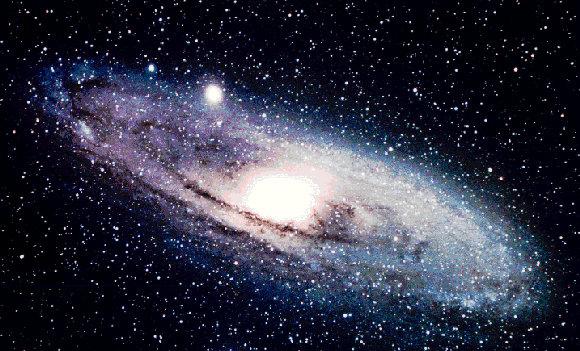|
|
Lectures
The course consists of two lectures a week, plus a coursework
exercise. The lecture titles are summarised below, including links to
copies of the lecture notes and other supporting material.
The pdf copies of the lecture notes are two slides per sheet on a white background,
and are the most suitable for printing out ahead of time to annotate in lectures. There are
no scheduled tutorials or problems classes for this course, but please
do feel free to contact the lecturer, by e-mail or in person, with any
questions you may have.
Seminars
This course includes four guest seminars. Generally, each seminar relates to
the content of the accompanying section of the course proper: for
example, the part of the course dealing with stars and stellar
evolution is associated with a seminar on binary stars. The exact
dates of the seminars are not known at this time, because they depend
on the availability of speakers, but will be announced as the course
progresses.
Please note that the seminars are examinable material! There
will be a question in the exam relating to the content of the
seminars.
Course Material
Introduction
Guest seminar:
Susan Cartwright: Neutrinos and the Universe
(ppt)
(pdf)
The Stars
| Title | Contents | links |
|---|
| Understanding Stars |
The Hertzsprung-Russell Diagram: main sequence, red giants and white dwarfs;
mass-luminosity relation; nuclear fusion as stellar power source;
stellar clusters
|
The lecture (pptx) (pdf)
Lecture summary
Self test
|
|---|
| The Lives of Stars |
Stellar structure; hydrogen fusion: main sequence and red giants;
helium fusion: horizontal branch and red giants; fusion efficiency
|
The lecture (pptx) (pdf)
Lecture summary
Self test
|
|---|
| Star Death |
Stellar lifetimes; stellar statistics;
the deaths of Sun-like stars: white dwarfs and planetary nebulae;
the deaths of massive stars: supernovae and pulsars;
the formation and abundance of heavy elements
|
The lecture (pptx) (pdf)
Lecture summary
Self test
|
|---|
| Star Birth |
From gas cloud to star; recognising young stars; star formation in action;
binary stars and planetary systems; brown dwarfs
|
The lecture (pptx) (pdf)
Lecture summary
Self test
|
|---|
Guest seminar:Vik
Dhillon: The Lives of Binary Stars
The Galaxies
| Title | Contents | links |
|---|
| The Milky Way |
Shape of the Milky Way, our location, location of stellar clusters;
Milky Way dynamics: disc, halo, spiral arms;
stellar populations; dark matter; the Galactic Centre
|
The lecture (pptx) (pdf)
Lecture summary
Self test
|
|---|
| Other Galaxies |
Distances of galaxies; elliptical and spiral galaxies; Hubble tuning fork;
groups and clusters; distribution of elliptical galaxies;
galaxies and cosmology
|
The lecture (pptx) (pdf)
Lecture summary
Self test
|
|---|
| Galaxy Evolution |
Formation of disc galaxy by collapse of gas cloud;
elliptical galaxies and galaxy collisions;
spiral arms as waves;
observations of young galaxies; active galaxies
|
The lecture (pptx) (pdf)
Lecture summary
Self test
|
|---|
Guest seminar: Clive Tadhunter: Black Holes (pdf version)
The Cosmos
| Title | Contents | links |
|---|
| Why is the night sky dark? |
What the darkness of the night sky tells us about the Universe;
Hubble's law;
a brief history of cosmological ideas
|
The lecture (pptx) (pdf)
Lecture summary
Self test
|
|---|
| The First 400,000 Years |
The first second: inflation, particle physics, and antimatter.
The first three minutes: creation of the light elements.
The End of the Beginning: production of the cosmic background radiation
|
The lecture (pptx) (pdf)
Lecture summary
Self test
|
|---|
| Echoes of the Big Bang |
The light elements and the density of the universe;
the background radiation and the geometry of the universe;
Type Ia supernovae and the future of the universe.
|
The lecture (pptx) (pdf)
Lecture summary
Self test
|
|---|
Guest seminar: Ed Daw: Dark Matter and the Universe
Planets and Life
| Title | Contents | links |
|---|
| Detection of Extrasolar Planets |
Methods for detecting extrasolar planets:
direct observation, astrometry, Doppler shift; selection biases;
properties of currently known extrasolar planets; theoretical studies
|
The lecture (pptx) (pdf)
Lecture summary
Self test
|
|---|
| Planets and Life |
Brief history of life on Earth and implications;
prospects for life elsewhere in solar system;
prospects for life elsewhere in Galaxy;
searches for life and for intelligence (SETI)
|
The lecture (pptx) (pdf)
Lecture summary
Self test
|
|---|
Guest seminar:Simon Goodwin: The Only Intelligent
Planet? (Susan's version)
|
Hicks Building, Hounsfield Road, Sheffield S3 7RH, UK
|

